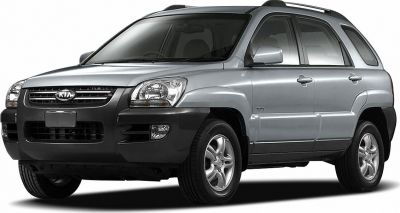 2003 Chevrolet Niva Dimensions, Size & Specs
2003 Chevrolet Niva Dimensions, Size & SpecsMeasurements of the 2003 Chevrolet Niva, engineered for optimal performance and comfort
| Dimensions | |
|---|---|
| Length: | 4048 mm159.4 in13.3 ft |
| Width: | 1770 mm69.7 in5.8 ft |
| Height: | 1652 mm65.0 in5.4 ft |
| Trunk Capacity: | 320 liter11.3 cu ft |
| Trunk Capacity (Max): | 650 liter23.0 cu ft |
| Weight Specifications | |
| Curb Weight: | 1350-1450 kg2976-3197 lbs |
| Maximal permitted Weight: | 1800-1850 kg3968-4079 lbs |
| Tire Specifications | |
| Tire Sizes: |
|
The Chevrolet Niva (2003 generation) is a compact SUV produced between 2002 and 2009, known for its robust design tailored for rugged conditions. It measures 4048 mm (159.3 inches) in length, 1770 mm (69.7 inches) in width, and 1652 mm (65 inches) in height, making it a practical vehicle for urban driving while retaining off-road capability. The curb weight ranges between 1350 and 1450 kg (2976 to 3197 lbs), supporting a maximum weight capacity of 1800 to 1850 kg (3968 to 4078 lbs). This balance contributes to a stable yet agile driving experience typical of compact SUVs. Luggage capacity is versatile, with 320 liters (11.3 cubic feet) available with rear seats upright and expanding to 650 liters (22.9 cubic feet) when the rear seats are folded down, providing flexibility for passenger and cargo needs. The Chevrolet Niva rides on tire sizes ranging from 205/70 R15, 205/75 R15 to 215/65 R16, allowing for optimal traction and comfort. Overall, the 2003 Chevrolet Niva is an ideal choice for drivers seeking a dependable SUV with moderate size dimensions and functional storage, suitable for both city environments and off-road adventures.
Discover the standout features that make the 2003 Chevrolet Niva a leader in its class
Have a question? Please check our knowledgebase first.
The Chevrolet Niva produced from 2002 to 2009 has a length of 4048 mm (approximately 159.4 inches or 13.3 feet), a width of 1770 mm (about 69.7 inches or 5.81 feet), and a height of 1652 mm (roughly 65 inches or 5.42 feet). These dimensions place it within the compact SUV segment, making it suitable for varied driving conditions including urban and off-road environments.
The curb weight of the Chevrolet Niva from 2002 to 2009 ranges between 1350 kg to 1450 kg (approximately 2976 lbs to 3197 lbs). Its maximum permitted weight is between 1800 kg and 1850 kg (roughly 3968 lbs to 4078 lbs). This weight allowance accommodates passengers, cargo, and any additional equipment, making the vehicle versatile for both everyday use and light to moderate off-road or cargo-carrying duties.
The Chevrolet Niva offers a luggage capacity of 320 liters (about 11.3 cubic feet) with the rear seats upright, which is sufficient for daily errands or short trips. When the rear seats are folded down, the luggage volume increases significantly to 650 liters (approximately 22.9 cubic feet), enhancing the vehicle's capability to transport larger items or increased cargo loads.
The suitable tire sizes for the Chevrolet Niva include 205/70 R15, 205/75 R15, and 215/65 R16. These tire dimensions provide a balance between road comfort, traction, and off-road performance. Larger tires such as 215/65 R16 may improve ground clearance and grip during off-road driving, while the 15-inch options tend to prioritize ride comfort and easier handling on paved roads.
Yes, the Chevrolet Niva fits comfortably into a standard residential garage. With a length of 4048 mm (159.4 inches or 13.3 feet), width of 1770 mm (69.7 inches or 5.81 feet), and height of 1652 mm (65 inches or 5.42 feet), it is well within typical garage size limits. Standard garages usually have door widths around 2400 to 2600 mm and ceiling heights above 2000 mm, so parking the Niva should be straightforward for most homeowners.
The Chevrolet Niva launched in 2002 is essentially a continuation and modernization of the original Lada Niva, which was known for its compact size and off-road capability. Although exact predecessor measurements can vary slightly depending on the year, the updated Chevrolet Niva is similar in overall proportions but generally features improved dimensions for enhanced passenger comfort and cargo capacity. Weight-wise, it tends to be a bit heavier due to added equipment, safety features, and reinforced components, enhancing durability and on-road stability.
When compared to other compact SUVs from the early 2000s, the Chevrolet Niva is notably more compact and rugged with an emphasis on off-road capabilities. Many competitors tend to be larger and heavier, focusing more on on-road comfort and interior luxury. The Niva’s smaller footprint, moderate dimensions (length around 4 meters, width 1.77 meters), and relatively low weight make it particularly agile in tight or uneven terrain, giving it an edge for buyers prioritizing affordable off-road utility over urban luxury.
The Chevrolet Niva accommodates up to five passengers with a two-row seating configuration. Its interior space is designed to maximize passenger comfort within its compact footprint. While legroom and headroom are adequate for average-sized adults, the interior more strongly emphasizes practical usability and durability rather than luxury. The rear seats fold down to expand the cargo area, which increases the vehicle's versatility for transporting larger items or outdoor equipment.
The Chevrolet Niva primarily targets consumers needing an affordable, reliable, and compact SUV with competent off-road ability. It has been popular in markets like Russia and other Eastern European countries where rough terrain and harsh weather conditions are common. Its simple mechanics, sturdy design, and moderate dimensions make it attractive for rural drivers, outdoor enthusiasts, and those requiring a vehicle for mixed urban and off-road use.
Choosing between tire sizes such as 205/70 R15, 205/75 R15, or 215/65 R16 on the Chevrolet Niva influences both handling and fuel economy. Larger tires like 215/65 R16 can improve off-road traction and ground clearance but may slightly reduce fuel efficiency and handling precision on paved roads due to increased rolling resistance and weight. Conversely, smaller tires such as 205/70 R15 typically provide better fuel economy and smoother on-road performance but may compromise some off-road capability. Vehicle owners should select tire sizes based on their primary use cases and driving conditions.
Discover similar sized cars.

| Production: | 1997-2006 |
|---|---|
| Model Year: | 1997 |
| Length: | 4025 mm158.5 in |
| Width: | 1764 mm69.4 in |
| Height: | 1650 mm65.0 in |

| Production: | 2019-present |
|---|---|
| Model Year: | 2019 |
| Length: | 3995 mm157.3 in |
| Width: | 1695 mm66.7 in |
| Height: | 1620 mm63.8 in |

| Production: | 2021-present |
|---|---|
| Model Year: | 2021 |
| Length: | 4099 mm161.4 in |
| Width: | 1804 mm71.0 in |
| Height: | 1690 mm66.5 in |
